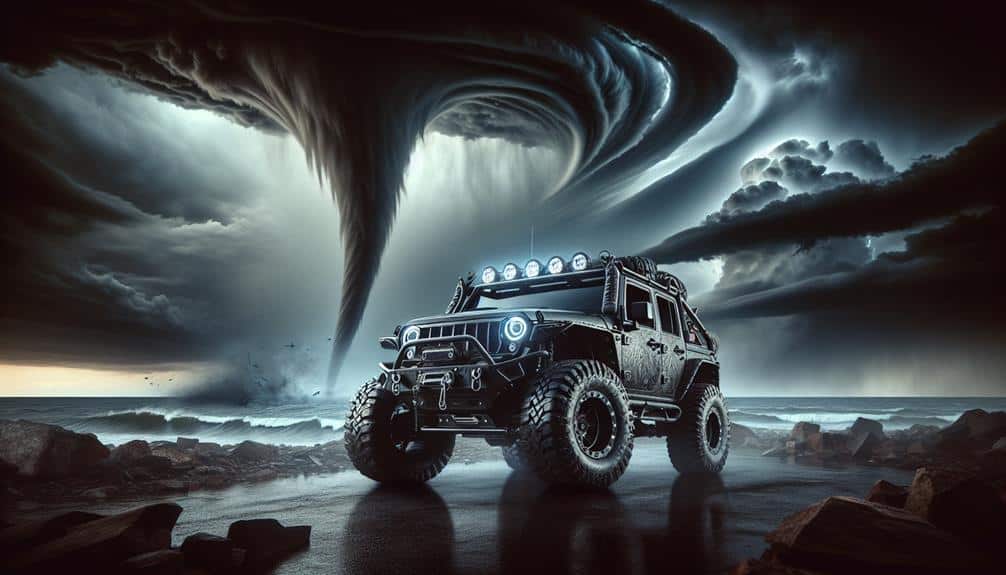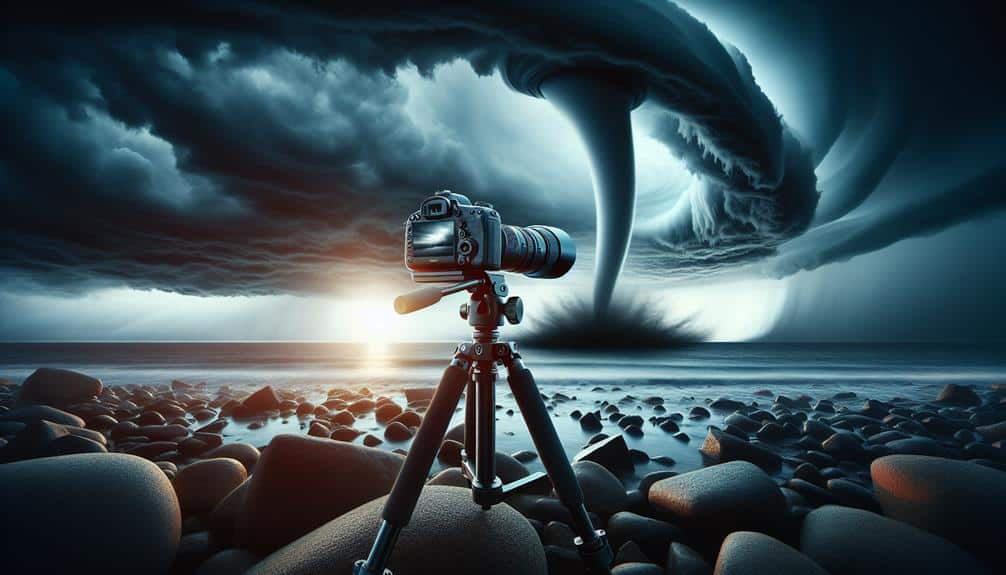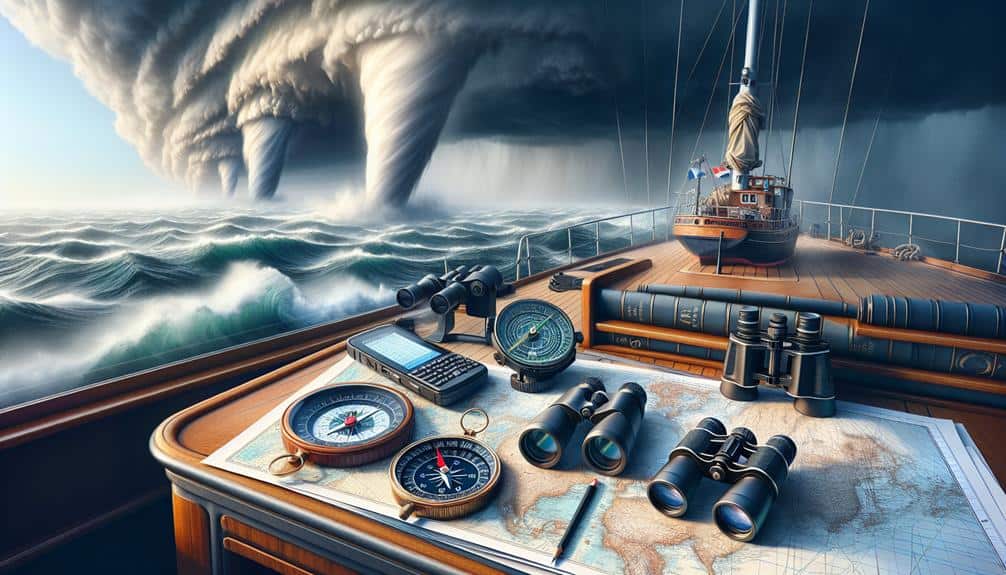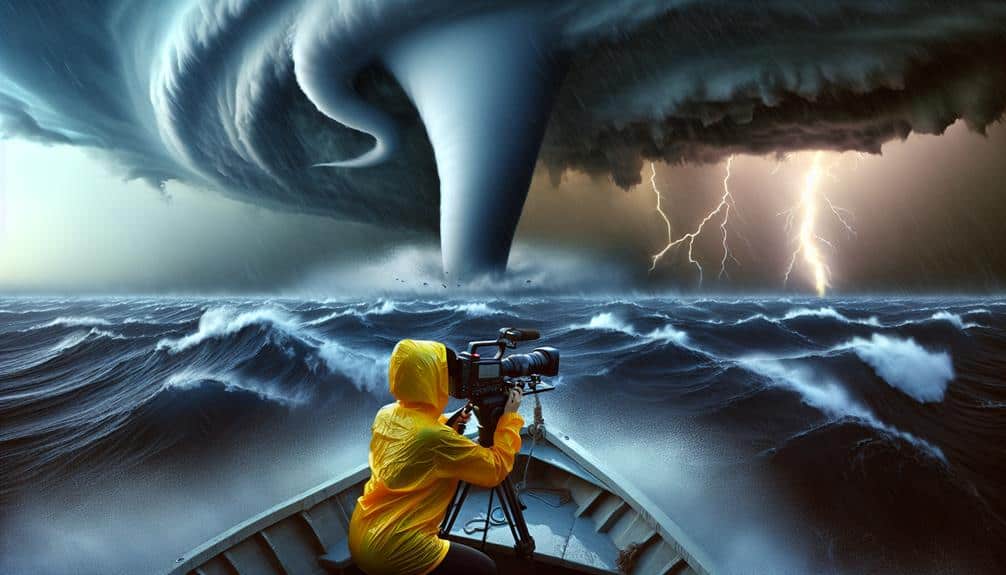When chasing waterspouts, we've got to start with a reliable vehicle boasting superior off-road capabilities and at least 8 inches ground clearance. We'll need weather-tracking tools, including real-time radar apps and satellite data access, for precise storm monitoring. A high-quality camera, preferably a 20MP DSLR with stabilization and a telephoto lens, is essential for capturing these phenomena. Protective clothing like waterproof and wind-resistant gear, along with sturdy footwear, is non-negotiable. Communication devices, such as satellite phones and two-way radios, keep us connected. Emergency supplies and advanced navigation equipment are indispensable. With these essentials, we'll be well-prepared for waterspout chasing missions.
Key Points
- Use a reliable, all-wheel or four-wheel drive vehicle with at least 8 inches of ground clearance for navigating rough conditions.
- Equip real-time radar apps and satellite data access for accurate weather tracking and waterspout formation identification.
- Capture high-quality images with a DSLR or mirrorless camera featuring rapid shutter speed and image stabilization, paired with a telephoto lens.
- Wear waterproof and wind-resistant clothing, including protective eyewear and sturdy footwear, to stay safe in adverse weather.
Reliable Vehicle

A reliable vehicle is necessary for successfully navigating the unpredictable and often harsh conditions encountered while chasing waterspouts. We need a vehicle with superior off-road capabilities and robust construction to handle diverse terrains, including sandy beaches and rugged coastlines. Equally important is the vehicle's ability to maintain stability and performance under adverse weather conditions, such as high winds and heavy rainfall.
Analyzing vehicle specifications, we should prioritize all-wheel drive (AWD) or four-wheel drive (4WD) systems, which enhance traction and control. Ground clearance is another vital metric; a minimum of 8 inches is advisable to navigate obstacles effectively. Tires should be all-terrain, rated for both wet and dry conditions, ensuring maximum grip.
Incorporating advanced safety features like electronic stability control (ESC) and anti-lock braking systems (ABS) can greatly reduce the risk of accidents. Additionally, having a dependable roadside assistance plan is essential. This service ensures we're not stranded due to mechanical failures, providing peace of mind and allowing us to focus on our mission.
Ultimately, our vehicle's reliability and off-road capabilities are key for ensuring our safety and success in the thrilling pursuit of waterspouts.
Weather-Tracking Tools
When chasing waterspouts, we must utilize advanced weather-tracking tools like real-time radar apps and satellite data access.
These tools provide critical meteorological insights and enhance our predictive accuracy.
Real-Time Radar Apps
Real-time radar apps provide us with critical, up-to-the-minute data essential for accurately tracking and predicting waterspouts. These tools empower our storm chasing tactics, allowing us to identify emerging weather patterns and make informed decisions on the fly. RadarScope and MyRadar are exceptional examples, offering high-resolution radar data that highlight precipitation intensity, velocity, and storm cell movement.
By integrating real-time radar information into our weather pattern analysis, we can pinpoint areas of rotation and potential waterspout formation. These apps provide detailed visualizations and customizable alerts, ensuring we're aware of sudden changes in atmospheric conditions. The ability to zoom in on specific regions and track storm cells in real-time enhances our situational awareness and safety.
Moreover, many radar apps include features like dual-polarization radar and lightning detection, which are invaluable for understanding the structure and intensity of storms. Leveraging these advanced functionalities, we can refine our approach, adjusting our positions to intercept the most significant weather phenomena with precision.
It's this data-driven approach that grants us the freedom to chase safely and effectively, maximizing our opportunities to witness and document waterspouts in their natural splendor.
Satellite Data Access
Satellite data access provides us with a detailed overview of atmospheric conditions, offering invaluable insights that enhance our ability to track and predict waterspouts. Leveraging advanced satellite coverage, we can monitor large swathes of the Earth's surface, capturing real-time data that's essential for our expeditions. This expansive view allows us to identify potential waterspout formations and assess the environmental factors contributing to their development.
By integrating satellite data with our existing weather-tracking tools, we can perform thorough data analysis, leading to more accurate predictions and timely decisions.
Here's what satellite data access offers:
- High-definition imagery: Allows us to pinpoint exact locations and monitor the evolution of weather systems.
- Infrared and visible light sensors: Provide crucial information on cloud formations, temperature variations, and moisture content.
- Geostationary and polar-orbiting satellites: Ensure continuous coverage and a broad perspective, essential for real-time monitoring.
Accessing this data empowers us with the knowledge and flexibility to navigate the complexities of waterspout chasing. By making informed decisions backed by robust data analysis, we maximize our chances of successful and safe expeditions.
High-Quality Camera

To capture the dynamic and often unpredictable nature of waterspouts, a high-quality camera with rapid shutter speed and advanced image stabilization is pivotal. In our experience, a DSLR or mirrorless camera with at least a 20-megapixel sensor provides the clarity needed for detailed images. Pairing the camera with the right accessories, such as lens filters, can enhance image quality by reducing glare and increasing contrast, vital when shooting in diverse lighting conditions.
We recommend using a telephoto lens with a focal length between 70-200mm to capture the distant and often fast-moving waterspouts. Incorporating neutral density (ND) filters can help manage exposure levels, especially in bright conditions, allowing for better control over shutter speed and aperture settings.
Mastering photography techniques is key. Utilize a fast shutter speed (1/1000s or faster) to freeze the motion of the waterspout.
For composition, following the rule of thirds can create balanced and engaging shots. Positioning the waterspout off-center and including elements like the horizon or nearby landmarks can add context and scale to your images.
Protective Clothing
While capturing stunning images of waterspouts is exhilarating, safeguarding our safety with the proper protective clothing is equally significant. The dynamic environment of a waterspout chase demands gear that can withstand unpredictable weather conditions and guarantee our well-being.
First, waterproof gear is essential. Staying dry not only maintains comfort but also prevents hypothermia in cooler conditions. Reliable brands offer data-backed performance metrics on water resistance, making it easier to select the best options.
Next, wind resistant clothing is essential. High-speed winds can impact body temperature regulation and mobility. Technical fabrics designed to block wind, like Gore-Tex, provide a barrier against the elements while allowing breathability.
Protective eyewear is another necessity. Winds can carry debris, posing a risk to our eyes. Polycarbonate lenses offer high impact resistance and clear vision even in turbulent conditions.
Our essential protective clothing checklist includes:
- Waterproof jackets and pants: Guarantee they've a high hydrostatic head rating.
- Wind resistant layers: Look for materials that offer both windproofing and breathability.
- Protective eyewear: Opt for ANSI Z87.1 certified safety glasses.
Safety equipment is non-negotiable in the pursuit of waterspout photography. Investing in high-quality, durable protective clothing ensures we can chase waterspouts with confidence and freedom.
Communication Devices

When chasing waterspouts, we must prioritize communication devices to guarantee our safety and coordination.
Reliable satellite phones offer 99% global coverage, vital for remote areas with limited cellular service.
Additionally, two-way radios with a range of up to 20 miles enable real-time team communication, necessary for executing timely maneuvers.
Reliable Satellite Phones
In the unpredictable world of waterspout chasing, it's important we equip ourselves with dependable satellite phones to guarantee uninterrupted communication in remote locations. Satellite phones offer a lifeline for emergency communication and receiving important weather updates when conventional networks fail. Given the nature of our pursuits, staying informed and connected can mean the difference between safety and danger.
When selecting a satellite phone, we must consider:
- Coverage Area: Ensure the satellite network covers our intended chase regions, especially maritime areas where waterspouts are prevalent.
- Battery Life: Opt for models boasting extended battery life, as prolonged outings in search of waterspouts can drain power quickly.
- Durability: Choose rugged, water-resistant phones that can withstand harsh weather conditions and inadvertent drops.
These devices not only facilitate emergency communication but also enhance our ability to stay ahead of shifting weather patterns. By incorporating reliable satellite phones into our gear, we're empowered to explore with confidence and maintain our connection to important information.
Let's not compromise on this vital aspect of our safety and efficiency in the field.
Two-Way Radio Essentials
To guarantee smooth team communication during waterspout chases, we must equip ourselves with high-quality two-way radios that offer reliable range and clear audio. When evaluating these devices, we should prioritize signal strength and battery life. Strong signal strength guarantees our messages aren't lost in the noise, essential when we're coordinating maneuvers in rapidly changing weather conditions.
First, let's consider the technical specifications. We need radios that operate on UHF frequencies, as they provide better penetration through obstacles like buildings or dense foliage. A range of at least 20 miles is ideal, ensuring we can maintain contact even when spread out. Models with adjustable power settings allow us to conserve battery life when full power isn't necessary, extending operational time.
Battery life is another key factor. Lithium-ion batteries are preferred due to their longer lifespan and quick recharge capabilities. A battery life of at least 12 hours guarantees our radios can last through a full day of chasing without needing a recharge. Additionally, radios with power-saving modes and battery status indicators help us manage our energy usage more efficiently.
With these features, we secure our communication remains uninterrupted, enhancing both safety and coordination during our waterspout chases.
Emergency Supplies
Having a well-stocked emergency supply kit is vital for guaranteeing our safety while chasing waterspouts. First aid and emergency shelter are key components that can't be overlooked. In the unpredictable environment of storm chasing, preparedness is paramount. Data shows that rapid response to injuries and immediate shelter can reduce the risk of severe outcomes by up to 70%.
Our emergency supply kit should include:
- First Aid Kit: A complete first aid kit, equipped with antiseptics, bandages, gauze, and necessary medications, ensures we can address injuries promptly.
- Emergency Shelter: Portable, weather-resistant shelters such as lightweight tents or emergency blankets provide immediate protection against the elements.
- Water Filtration System: Clean drinking water is essential. A portable water filter or purification tablets can prevent dehydration and waterborne illnesses.
This detailed planning frees us from worrying about basic survival needs, letting us focus entirely on the thrill and scientific pursuit of waterspout chasing. By integrating these crucial supplies, we enhance our resilience and readiness, guaranteeing that we can safely navigate the challenges posed by severe weather phenomena.

Effective navigation equipment is necessary for successfully tracking and documenting waterspouts. We rely on advanced GPS technology to pinpoint our exact location and to guarantee we stay within safe boundaries. This precision is crucial when we're out on the open water, where landmarks are sparse and conditions can change rapidly. A reliable GPS unit with real-time updates helps us chart our course accurately.
Compass navigation serves as an important backup to our electronic systems. We can't afford to overlook the significance of a traditional magnetic compass, especially in scenarios where electronic devices might fail. Keeping a steady course with compass navigation ensures we can always find our way back, regardless of technological hiccups.
Marine charts are indispensable for understanding the geography and underwater topography of our surroundings. Detailed marine charts provide data on water depths, hazards, and navigational aids that are essential for safe passage. Coupled with depth finders, these charts help us avoid shallow areas and submerged obstacles that could compromise our mission.
Frequently Asked Questions
What Safety Measures Should Be Taken When Chasing Waterspouts?
When chasing waterspouts, we should prioritize safety precautions and equipment. Monitor weather conditions constantly, adhere to emergency protocols, and guarantee our vehicle is equipped with GPS, communication devices, and first aid kits to maintain safety and freedom.
How Close Can You Safely Get to a Waterspout?
We walk a tightrope between thrill and peril. Distance limits and safety precautions are essential. Through risk assessment and observation techniques, we determine that staying at least 1 kilometer away guarantees safety while granting the freedom to witness nature's fury.
What Are the Best Locations for Spotting Waterspouts?
To find the best locations for spotting waterspouts, let's target popular destinations like the Florida Keys and the Great Lakes. These areas offer ideal conditions with warm waters and frequent thunderstorms, enhancing our chances of successful sightings.
Can Drones Be Used for Capturing Waterspouts?
Yes, we can use drones for capturing waterspouts. Their advanced drone capabilities enable high-resolution imaging and real-time data collection, providing critical information for analysis while allowing us the freedom to explore dangerous areas safely.
Are There Any Legal Restrictions on Waterspout Chasing?
We must consider legal restrictions and ethical considerations when chasing waterspouts. Regulations may vary by region, but they often focus on safety and environmental protection. Always check local laws to guarantee compliance and responsible behavior.


